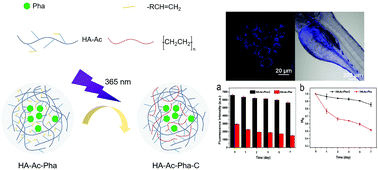A novel cross-linked nanoparticle with aggregation-induced emission properties for cancer cell imaging†
Abstract
Fluorescent probes have been widely used in bioimaging as an efficient and convenient analytical tool. From the initial inorganic nanoparticles and small organic molecules to polymeric nanoparticles, scientific researchers have been trying to develop a probe with strong fluorescence and excellent biocompatibility. In this study, a tetraphenylethylene derivative with AIE properties and hyaluronic acid modified by methacrylic anhydride were combined to prepare a novel nanoparticle (HA-Ac-Pha-C) as a fluorescent probe by a photochemical cross-linking reaction. The fluorescence intensity and size of the nanoparticles were characterized by different techniques. It was confirmed that cross-linked nanoparticles not only showed stronger fluorescence, but also had better photostability while still maintaining 85.9% of the initial intensity after seven days. Moreover, cells and zebrafish imaging experiments also demonstrated that nanoparticles show specific fluorescence labeling for cancer cells and excellent biocompatibility in living organisms.



 Please wait while we load your content...
Please wait while we load your content...